
In most B2B software and tech companies, marketing and sales operate as separate departments who often view each other as enemies rather than allies.
As a prospect progresses down the sales funnel, this creates problems since it’s often assumed that marketing should be solely responsible for lead generation, while sales is solely responsible for closing.
This couldn’t be farther from the truth.
By the time a prospect is qualified to talk to a salesperson, your company has already invested a great deal of time, energy and marketing dollars to nurture that lead. If there isn’t a seamless pass off between departments, you’re risking that relationship.
To make sure your sales team has all of the knowledge and resources they need to take over SQLs (sales qualified leads), your marketing team should go beyond lead gen and focus on strategic sales enablement to fill that gap in the sales funnel. (After all, 71% of companies say closing more deals is their top sales priority.)
Simply put, sales enablement is a strategic partnership between sales and marketing.
It happens when marketing provides tools, technology and information to support the sales team. This support enables sales teams to spend less time creating half-branded assets—like emails and flyers—and more time actually helping prospective buyers make informed decisions.
Specific marketing deliverables that can support sales teams include tools like value proposition training, sales presentations, case studies, testimonials, and ROI worksheets.
The important thing to remember is that sales enablement is really less about selling, and more about helping the buyer continue their process down the sales funnel.
Sales enablement can apply to your own internal sales team, as well as any channel partner who works as an extension of your organization.
Done right, sales enablement helps align sales and marketing, and ensures efficiencies across the board. Adopting sales enablement in your organization will help maximize your marketing team’s lead generating efforts and your sales team’s productivity by:
Plus, you’ll start to close more deals, faster than ever before!
In its simplest of form, inbound marketing is what drives lead generation—or what fills the top of the sales funnel. Sales enablement, on the other hand, supports bottom-of-the-funnel activities.
When you put the two together, you address the full sales funnel by providing information for your buyer’s at every stage of their buying journey.

But keep in mind, buyers don’t follow your funnel as perfectly as you have planned—far from it, in fact. So, when your sales enablement and inbound marketing efforts work together, a cohesive message follows them throughout your buyers’ entire journey. This way, your prospects don’t get one message from your website, then get surprised later in their journey by a different message from a sales rep. Your brand should be reflected in both inbound lead generation and sales enablement content.
For good reason, strategic sales enablement is arguably more important in technology than in any other industry. For starters, B2B software and tech solutions are often custom and complex in nature. So, buyers spend more time in the consideration and decision stages when compared with “off-the-shelf” products.
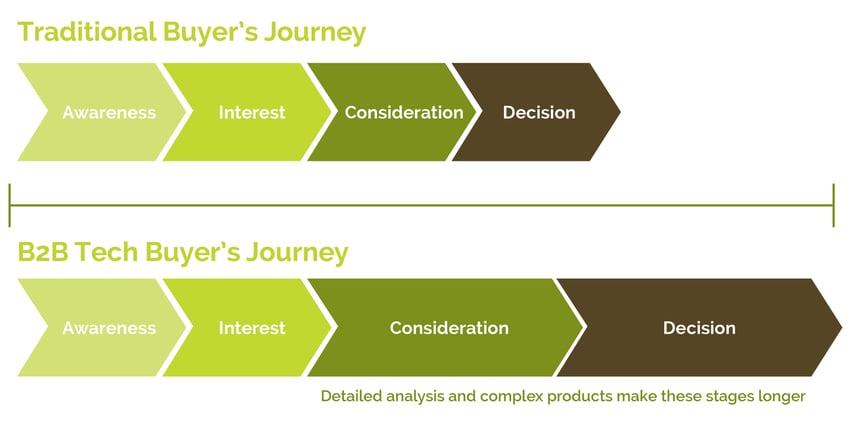
Additionally, B2B technology solutions often impact the way companies do business altogether. So, sales reps tend to function more as business consultants vs. a traditional sales person focused on making a quick sale. As a result, B2B software sales reps need access to tools on-demand that help them demonstrate value, respond to common objections, answer FAQs and solve their prospect's overall business need.
By creating bottom-of-funnel resources that your sales team can access on-demand, your marketers can help position sales reps as trusted advisors who aid prospects in making informed decisions.
When diving into to sales enablement, it may be tempting to focus solely on the needs of your sales team, asking, “What does the sales team want?”
Big erroneous buzzer sound! This will start you out on the wrong foot right off the bat.
When creating your sales enablement strategy, there are two (and only two) questions you need to consider:
For example, you may know that you have an 85% chance of winning the business if you get someone to the proposal phase. But, what do you need to provide buyers to get them to this stage?
And, while it’s important to involve your sales team in the process of building your sales enablement infrastructure, it’s equally as important for them to understand the need to prioritize assets based on buyer’s goals and business goals in mind. Think product (or service) value points, buyer’s pain points and techniques that your sales team has previously used to successfully close deals.
With your buyer in mind, you can then dig into building your strategy.
It doesn’t matter how many leads you attract if your sales team can’t answer questions about your product or isn’t great at closing deals. Effective sales training is key to increasing sales efficiency and profitability.
When onboarding new sales reps, it’s important to be transparent about your company, your products or services and the team’s structure, processes and responsibilities. This will help new sales reps understand how the team functions and where they fit in the system. Teach them the mission and vision of your business and how to communicate that through the value of your product.
Also, consider implementing programs or incentives that entice your sales team to keep learning. Your sales reps need to be experts in your product, and know-how to demonstrate the use of it. Give them on-demand access to review resources, like training, wherever and whenever they need it.
Establishing a process for regular communication is an important part in developing your sales enablement strategy.
With a dedicated process for engaging your sales team, you ensure there’s a continuous feedback loop on how the tools are working. Your engagement strategy can include tools like feedback forms or regular workshops between sales and marketing.
When sales is actively part of the process, they're more likely to buy-in, which means the program is more likely to be successful in the long run.
Marketers can help the sales team focus more of their time on being a valuable resource to prospects by developing an online, centralized resource library. The key to a good resource library is the ability for users to easily and quickly find the tools and resources they need when they need them.
A tool like this can store and categorize your approved resources. This way, your sales team can easily access an on-demand toolkit chock full of training and branded materials created by marketing experts to engage and convert potential buyers.
Only a short time ago, sales was a very manual process. Personal phone calls were made, business cards were kept in a Rolodex and business contracts were done in-person. But, today’s tech-savvy buyer expects modern, timely tools delivered electronically, especially when shopping for business technology solutions.
Many processes that used to be manually handled by the salesperson can now be streamlined with technology platforms, while some tasks can be automated altogether.
And, your technology platforms will be the way that you measure success of tools and processes.
Marketing automation tools like HubSpot not only support your inbound marketing efforts, but they can also serve as the engine for your sales enablement. These platforms can automate some elements of sales enablement, and they can operate as the hub for sales enablement tools like resources and email templates.
When digging into the content creation, you’ll find that there are many parallels in the types of content needed for sales enablement, as compared to inbound marketing or lead generation. However, in sales enablement this content is often more technical, in-depth and answers more questions regarding the features and exact functionality of the solution.
Keep in mind, marketers don’t have to be the only ones creating this content. There are many areas where sales will serve as the expert in the content, and they’ll look to marketing to refine the message and ensure that it is consistent with the brand and other tools.
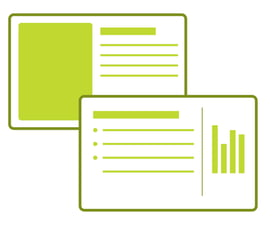
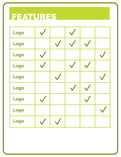
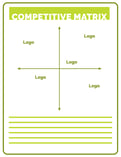

In addition to content pieces, some sales enablement tactics fall more into the “optimization” category.
For example, this could include working with your sales team to ensure their LinkedIn profiles are polished and professional, contributing to your buyer’s total outlook on your brand, which can then make a difference in their decision making. You want your sales reps to be seen as professional partners when they engage with these prospects at the middle or bottom of the funnel.
Website chat functionality is another method of sales enablement that falls more into optimization vs. content. Chat is becoming increasingly popular on B2B websites. Approaching this strategically means making sure you have a process that is nimble—you want to be easily able to align your prospects with a sales rep when they’re asking good questions via chat. Don’t make your prospects wait until you take their request offline, manually add them into your CRM, and send an email to your sales rep to let them know they have a new lead.
One area that is begging for a strategic sales enablement process is trade show activation.
Trade show planning and execution is an area in many businesses, especially in B2B software, where sales enablement is often approached more on an ad hoc basis. Commonly, marketing will try to get folks to the booth, and sales reps will follow up with those who drop their business cards in a bowl.
Trade shows are a big investment, meaning that it is important that you can demonstrate the value. And the value is much more than the number of business cards left at the booth; as marketers, you want to drive meaningful traffic to the booth, then ultimately assist your sales team in turning those leads into happy clients.
Some trade show enablement tools include:
With a comprehensive trade show approach with both lead gen and sales enablement closely aligned, trade show attendees will see the same message about your brand and product from multiple channels, and it will be exponentially more effective.
In getting started with a strategic sales enablement approach, you’ll need buy-in from a few key stakeholders.
If you don’t already have buy-in from the leadership team, you’ll have to start there. It’s not uncommon to hear from the c-suite that marketing’s purpose is solely lead generation. But because your business leaders are responsible for the overall growth and success of the organization, you’ll likely have a listening ear when you say that you can further support those business goals by helping your sales team close more deals. Support from the leadership team will also aid in the buy-in from the next group of stakeholders…
It’s not uncommon for sales to feel that marketing stepping into this arena is an invasion of their space. To grow that relationship, marketing should be immersed in sales… attending weekly sales calls to hear first-hand where there are gaps, needs or areas of opportunity. When the sales team sees that you’re going to make them more successful— and ultimately make their jobs easier—you’ll begin to gain their trust.
And finally, you’ll need buy-in from your whole marketing team, including any writers or designers you may have on the team. The marketing team should be the champions of this endeavor. It’s important for sales to see marketing as a valuable resource.
In measuring the results of any marketing activity, it's easy to measure to closed deals…but that doesn’t always tell the whole story of everything that came in between.
B2B software typically has a long sales cycle, which can make certain tactics difficult to measure as standalone activities. And that can make the combined marketing and sales efforts overall more challenging to measure.
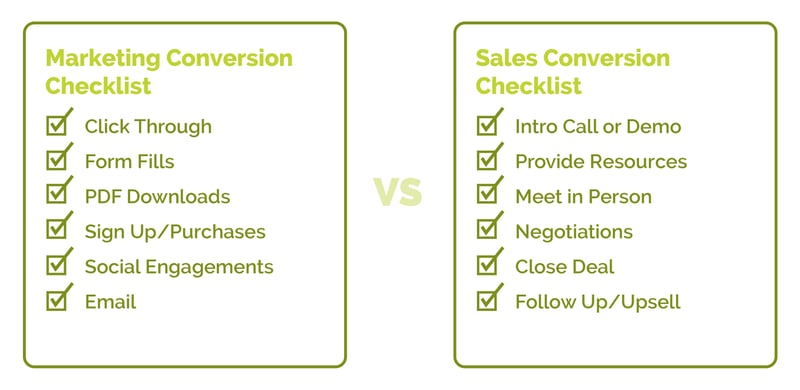
If marketing is generating a slew of leads, but sales is unable to close those deals, perhaps the leads weren’t qualified? Or perhaps they were handed off to sales too soon? Or perhaps sales didn’t have the right tools in hand to close the deal?
When marketing provides tools to sales, they are creating a strategic system that addresses the total sales funnel, that is also measurable and actionable.
For example, when marketing creates an email template “toolbox” for sales to use as they are walking the buyer through the final technical discussions, marketing can then measure the effectiveness of that content. Then, marketing and sales can work together to optimize those tools for future use.
In determining how you’re going to measure success for your unique business, consider quantitative sales metrics you can measure, like an increase in average deal size or a shortened sales cycle. But, it’s also important to track long-term qualitative results, like sales team satisfaction and engagement. After all, you want to make sure that as the face of your brand, your sales people are as knowledgeable and passionate about your product as they can be.
And of course, your number of closed deals is always a great and easy thing to measure.
Ready to get started with sales enablement? Or looking to take your existing sales enablement efforts to the next level?
We can help.
Kiwi Creative is a HubSpot Gold Agency Partner that specializes in working with B2B software and technology customers. And, hopefully, after reading this web page, you can tell that we know our stuff.
We're a small, but talented, team of strategists, writers, designers, technologists and developers…all ready to help in-house marketing managers at tech companies with inbound marketing, branding, website design and, of course, sales enablement.
Want to chat about an upcoming project? Schedule a call with Jen when it's convenient for you!